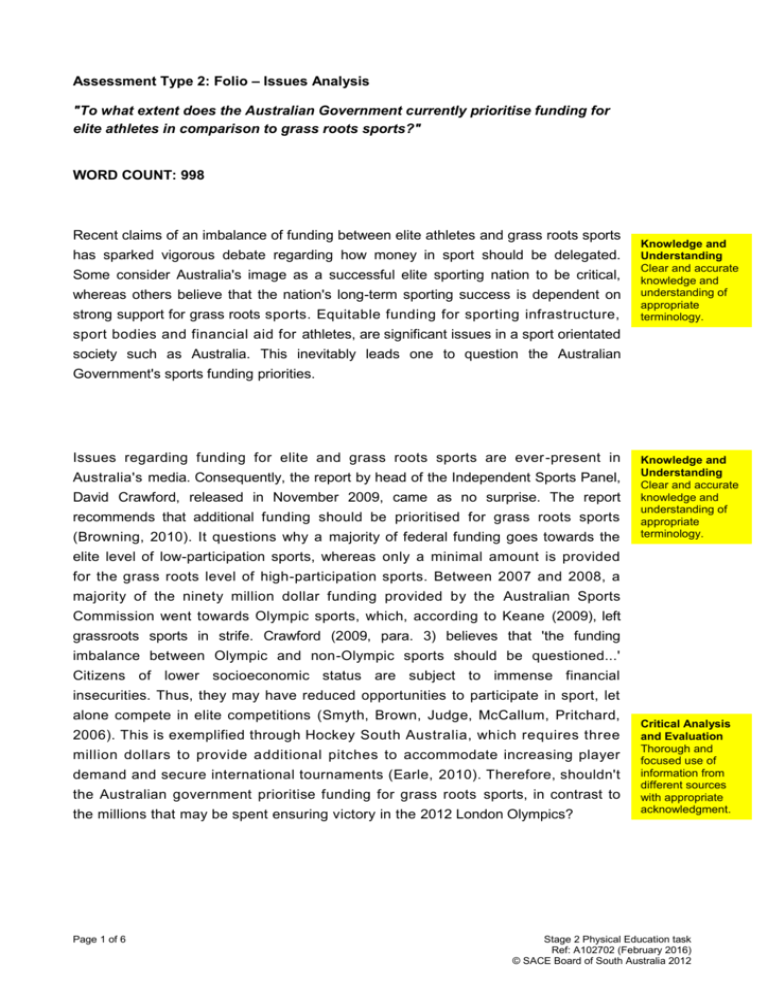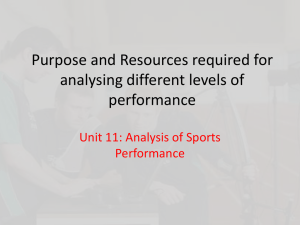Student 3 response
advertisement

Assessment Type 2: Folio – Issues Analysis "To what extent does the Australian Government currently prioritise funding for elite athletes in comparison to grass roots sports?" WORD COUNT: 998 Recent claims of an imbalance of funding between elite athletes and grass roots sports has sparked vigorous debate regarding how money in sport should be delegated. Some consider Australia's image as a successful elite sporting nation to be critical, whereas others believe that the nation's long-term sporting success is dependent on strong support for grass roots sports. Equitable funding for sporting infrastructure, Knowledge and Understanding Clear and accurate knowledge and understanding of appropriate terminology. sport bodies and financial aid for athletes, are significant issues in a sport orientated society such as Australia. This inevitably leads one to question the Australian Government's sports funding priorities. Issues regarding funding for elite and grass roots sports are ever -present in Australia's media. Consequently, the report by head of the Independent Sports Panel, David Crawford, released in November 2009, came as no surprise. The report recommends that additional funding should be prioritised for grass roots sports (Browning, 2010). It questions why a majority of federal funding goes towards the Knowledge and Understanding Clear and accurate knowledge and understanding of appropriate terminology. elite level of low-participation sports, whereas only a minimal amount is provided for the grass roots level of high-participation sports. Between 2007 and 2008, a majority of the ninety million dollar funding provided by the Australian Sports Commission went towards Olympic sports, which, according to Keane (2009), left grassroots sports in strife. Crawford (2009, para. 3) believes that 'the funding imbalance between Olympic and non-Olympic sports should be questioned...' Citizens of lower socioeconomic status are subject to immense financial insecurities. Thus, they may have reduced opportunities to participate in sport, let alone compete in elite competitions (Smyth, Brown, Judge, McCallum, Pritchard, 2006). This is exemplified through Hockey South Australia, which requires three million dollars to provide additional pitches to accommodate increasing player demand and secure international tournaments (Earle, 2010). Therefore, shouldn't the Australian government prioritise funding for grass roots sports, in contrast to the millions that may be spent ensuring victory in the 2012 London Olympics? Page 1 of 6 Critical Analysis and Evaluation Thorough and focused use of information from different sources with appropriate acknowledgment. Stage 2 Physical Education task Ref: A102702 (February 2016) © SACE Board of South Australia 2012 In response to the Crawford Report, in May 2010, the Australian Government released the report 'Australian Sport - the Pathway to Success'. It is backed by what was described as the 'biggest...funding injection to Australian sport' (Jeffrey, 2010, p. 24); a $195,000,000 boost for elite and grass roots sport. Federal Sports Minister, Kate Ellis (2010), guarantees that national sporting organizations will be Knowledge and Understanding Clear and accurate knowledge and understanding of appropriate terminology. prioritised with additional funding to increase community participation. This will be complemented by the introduction of a strategic 'whole-of-sport' approach to strengthen sporting pathways. Ellis (2010) contends that this will help the sport system prepare for future challenges and increase the success of lower socioeconomic individuals. Through this additional funding, Coates believes that elite athletes will be able to 'prepare properly' for the 2012 Olympics (Jeffrey, 2010, p. 7), thus strengthening Australia's chances of success. Furthermore, future Olympians wil l not have to sacrifice their financial security to train, work and study in a bid to represent Australia (Jeffrey, 2010). This is demonstrated by Murray Stewart, a potential kayaker for the 2012 Olympics, who feels it is a '...struggle financially so any Critical Analysis and Evaluation Perceptive and critical analysis and evaluation of an issue related to physical activity and clearly relevant to local, regional, national or global communities. assistance is greatly appreciated' (Jeffrey, 2010, p. 7). Through this funding boost, it appears the government is, to a certain extent, placing equal priority upon elite and grass roots sports. Recently, sporting infrastructure issues have arisen, with sporting representatives voicing their concerns that grass roots sport is not being provided with equal funding. This is illustrated by Basketball South Australia boss Mark Hubbarb, who believes sporting '...infrastructure in SA is third world quality' (Earle, 2010, p. 118). Local Government Association President, Mayor Felicity-Ann Lewis, believes Knowledge and Understanding Clear and accurate knowledge and understanding of appropriate terminology. the Government seems 'more intent on building elite sport stadiums' than fixing 'inadequate' grass roots facilities' (Homfray, 2010, para. 10). For instance, despite the fact that soccer will grow more than 10 percent in 2011, the Football Federation of South Australia is still waiting for the Government's response to its 14.7 million dollar Community Facility request (Earle, 2010). This is a modest figure compared to projects such as Adelaide Oval's $535,000,000 redevelopment (N.A. 2010). FFSA chief executive, Michael Carter, believes there is a significant need for investment by the Government, as currently, FFSA is '...servicing around 70 players Critical Analysis and Evaluation Perceptive and critical analysis and evaluation of an issue related to physical activity and clearly relevant to local, regional, national or global communities. per pitch in Adelaide' (Earle, 2010, p. 118). Soccer is not alone in its funding plight. Other sports, such as Softball South Australia, which requires a modest $500,000 for an upgrade of its facilities, are feeling marginalised. Sports South Australia chief executive, Jan Sutherland, believes the government is investing in larger sporting infrastructure projects with '...no other discussion of the needs of sport' (Earle, 2010, p. 118). These observations indicate that, to a large extent, the Australian Government still prioritises elite sports over grass roots sports. Page 2 of 6 Stage 2 Physical Education task Ref: A102702 (February 2016) © SACE Board of South Australia 2012 However, despite this inequity, some sporting infrastructure projects benefit grass roots sports. An example is Sydney Olympic Park, home to a development team that increases opportunities for grass roots communities to use the facilities of one of Australia's premier sports hub (Houhlias, N.D). In Western Australia, grass roots sports recently gained a $20,000,000 sporting infrastructure investment from the Government in acknowledgment of the benefits sport provides to communities (Antartis, 2010). WA Sport and Recreation Minister, Terry Waldron, pledges that 'these funds [will] ensure grass roots sport...can...provide opportunities for people to be active' (Antartis, 2010, para. 9). Consequently, Government is now looked upon more favourably concerning the prioritisation of elite and grass roots sports. By recognising the importance of sporting participation, increasing infrastructure funding and financial support for athletes, the Australian Government is, to a certain extent, providing equal funding and prioritisation for elite and grass roots sport. By doing so, the government is improving the sporting system's capacity and effectiveness (Ellis, 2010). However, inequality of funding between elite and grass roots sports still persists. This is evident through issues such as lack of infrastructure for grass roots sports, funding bias and less regard for Australians of lower socioeconomic status. Therefore, despite recent initiatives, the government Knowledge and Understanding Clear and accurate knowledge and understanding of appropriate terminology. does not currently prioritise funding for grass roots sports in comparison to elite athletes. Due to this disparity, there is an evident need for greater equity in the Australian Government's expenditure on sport. Page 3 of 6 Stage 2 Physical Education task Ref: A102702 (February 2016) © SACE Board of South Australia 2012 References Antartis, J 2010, 'Grass roots sport infrastructure wins in $20 million investment', viewed 20 July 2010, <http://www.med iastatements.wa.gov.au/Lists/Statements/DispForm.aspx?ID=133190>. ABC Sport, Browning, J 2010 May 11, 'AOC says budget 'ticks all the boxes, viewed 20 June 2010, <http://www.abc.net.au/news/stories/2010/05/11/2896712.htm>. Crikey, Keane, B 2009 November 19, 'Sport funding torn between going for gold and going for guts', viewed 20 June 2010, <http://www.crikey.com.au/2009/11/17/sportfunding-torn-between-going-for-gold-and-going-for-guts>. Earle, R 2010, 'Just how much would an extra $85 million add you your favourite sport?', The Advertiser, 29 May, p. 118. Earle, R 2010, 'Minor' sports left in the dark', The Advertiser, 29 May, p. 118. Hinds, R 2010, 'Elite still the focus of funds- BACKLINES', The Age, 15 May, p. 10. Critical Analysis and Evaluation Thorough and focused use of information from different sources with appropriate acknowledgement. Homfray, R 2010, 'Cry goes out- what about the rest of sport?', The Advertiser, 18 March, N.A. Sydney Olympic Park, Houhlias, T. (n.d.), 'Sports Business Opportunities', viewed 27 June 2010, <http://www.sydneyolympicpark.com.au/Home_of_sport/sports_development>. Jeffrey, N 2010, 'Funds top-up eases elite athletes' burden- THE FEDERAL BUDGET 2010', The Australian, 13 May, p. 7. Jeffrey, N 2010, 'Plan to 'rain on' London's parade- FEDERAL BUDGET 2010', The Australian, 12 May, N.A. Kate Ellis Ministerial office in Canberra, 2010. McGuire, M 2010, 'Numbers Game', The Advertiser, 19 June, p. 15. NA 2010, 'Many can see better use for Oval project money', The Advertiser, 7 June, p. 18. Silkstone, D 2010, 'Coates 'delighted' with big funding boost- OLYMPICS', The Age, 12 May, P. 9. Smyth, D, Brown, H, Judge, W, McCallum, C, Pritchard, R, 2006, 'Monitoring and Promotion of Physical Activity', in Live It Up 2, John Wiley & Sons Australia, Ltd, Queensland, p. 23. Page 4 of 6 Stage 2 Physical Education task Ref: A102702 (February 2016) © SACE Board of South Australia 2012 Response 3 Additional comments Introduction displays: effective outlining of the issue and the contrasting opinions. Analysis displays: accurate use of language and appropriate terminology relevant contrasting opinions accurate referencing with relevant quotes and statistical information effective use of a range of relevant examples. Conclusion displays: effective summary of the issue with pertinent conclusions drawn accurate knowledge of the issue expressed through appropriate acknowledgment. Referencing: evidence of information gathered from a considerable range of sources with relevant, up-to-date details and with appropriate acknowledgment. Possible considerations for further development of the response: some statements are a little out of context, needing further substantiation and linking some references need to be better tied to the direction of the discussion. Page 5 of 6 Stage 2 Physical Education task Ref: A102702 (revised January 2013) © SACE Board of South Australia 2012 Performance Standards for Stage 2 Physical Education Knowledge and Understanding A In-depth knowledge, informed understanding and accurate application of physical education concepts relevant to specific physical activities. In-depth knowledge and understanding of exercise physiology, the biomechanics of human movement, and skills acquisition. Practical Skills Application A high level of proficiency in the performance of physical activities, with reference to specific skills criteria. Accurate interpretation and proactive application of skills, specific concepts, ideas, strategies, and techniques, in a practical context. Initiative and Collaboration Critical Analysis and Evaluation A proactive approach to demonstrating initiative, self-reliance, and leadership in practical activities. Constructive and confident interpersonal and collaborative skills in team situations. Well-considered knowledge, informed understanding and application of physical education concepts relevant to specific physical activities. Some depth of knowledge and understanding of exercise physiology, the biomechanics of human movement, and skills acquisition. Proficiency in the performance of physical activities, with reference to specific skills criteria. Capable interpretation and active application of skills, specific concepts, ideas, strategies, and techniques, in a practical context. An active approach to demonstrating initiative, self-reliance, and leadership in practical activities. Confident interpersonal and collaborative skills in team situations. Considered knowledge, informed understanding and competent application of physical education concepts relevant to specific physical activities. Considered knowledge and understanding of exercise physiology, the biomechanics of human movement, and skills acquisition. Competent performance in physical activities, with reference to specific skills criteria. Competent interpretation and application of skills, specific concepts, ideas, strategies, and techniques, in a practical context. Generally effective demonstration of initiative and self-reliance, and some contribution to leadership in practical activities. Appropriate interpersonal and collaborative skills in team situations. Competent knowledge and understanding of appropriate terminology. D Recognition and some understanding and application of physical education concepts relevant to one or more specific physical activities. Some recognition and understanding of aspects of exercise physiology, the biomechanics of human movement, and/or skills acquisition. Some competence in aspects of the performance of physical activities, with reference to specific skills criteria. Occasional demonstration of initiative and selfreliance in practical activities, with support. Inconsistent interpretation and application of skills, specific concepts, or ideas, in a practical context. Occasional demonstration of collaborative skills in team situations, with some use of interpersonal skills. Limited performance in one or more physical activities, with reference to specific skills criteria. Limited awareness of aspects of exercise physiology, the biomechanics of human movement, or skills acquisition. Emerging ability to interpret or apply skills, specific concepts, or ideas, in a practical context. Page 6 of 6 Logical evaluation of the relevance of principles and concepts to a given situation. Critical analysis and evaluation of an issue related to physical activity and relevant to local, regional, national, or global communities. Some critical analysis of practical techniques and performance, with a tendency to rely on description. Generally clear evaluation of the relevance of principles and concepts to a given situation. Some critical analysis and evaluation of an issue related to physical activity that has some relevance to local, regional, national, or global communities. Some consideration and basic description of a narrow range of practical techniques and performance. Some consideration of the relevance of principles and concepts to a given situation. Basic description of some aspects of an issue related to physical activity but with limited relevance to local, regional, national, or global communities. Some use of information from more than one source, with attempted acknowledgment. Limited awareness and application of one or more physical education concepts. Limited awareness of basic terminology that may be appropriate. Detailed critical analysis of practical techniques and performance. Competent use of information from different sources, with appropriate acknowledgment. Some recognition and understanding of basic terminology that may be appropriate. E Perceptive and critical analysis and evaluation of an issue related to physical activity and clearly relevant to local, regional, national, or global communities. Mostly focused use of information from different sources, with appropriate acknowledgment. Mostly clear knowledge and understanding of appropriate terminology. C Highly discerning evaluation of the relevance of principles and concepts to a given situation. Thorough and focused use of information from different sources, with appropriate acknowledgment. Clear and accurate knowledge and understanding of appropriate terminology. B Thorough and insightful critical analysis of practical techniques and performance. Some recognition of the need for initiative, selfreliance, or leadership in practical activities. Emerging collaborative skills in team situations, with limited use of interpersonal skills. Identification and some limited description of one or more practical techniques or performance. Recognition of the need to consider the relevance of principles and concepts for a given situation. Disconnected description of an issue related to physical activity. Attempted use of information from a source, with limited acknowledgment. Stage 2 Physical Education task Ref: A102702 (revised January 2013) © SACE Board of South Australia 2012








